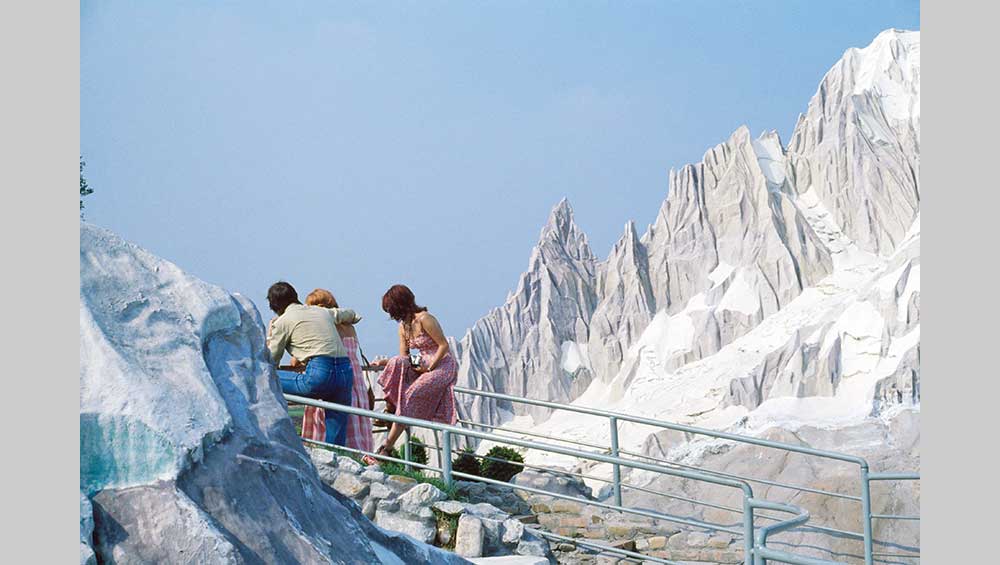
Luigi Ghirri. Rimini, 1977. Lambda print, new print (2022). Courtesy Estate of Luigi Ghirri. © Estate of Luigi Ghirri.
MASI (Museo d’arte della Svizzera Italiana), Lugano, Switzerland
8 September 2024 – 26 January 2025
by VERONICA SIMPSON
There is a wonderful photo by Luigi Ghirri (b1943, Scandiano, d1992, Reggio Emilia) used in the posters advertising this show celebrating his thoughtful and poetic sensibility. It is a shot of three tourists set against a craggy mountainscape, which they are clearly admiring. From the cropped frame of the poster, you could imagine that this is a real mountain range, but when you see the expanded print in the exhibition, many other layers are revealed: on the purely visual level, you find yourself admiring the way Ghirri has framed the outline of the three figures to dialogue with the peaks and folds of the landscape at which they are gazing. Then you find yourself noticing their clothes, and maybe wondering why they would be standing on the summit of such a vast Alpine range in their 1970s holiday best – the man in high-waisted jeans and a yellow polo shirt, the women in strappy patterned dresses and high-heeled wedge sandals. You realise they are tourists. A clue lies by their feet: a casually discarded Coca-Cola cup rests against the metal railings that are on either side of their lofty position to safeguard the walkway that got them there. These are not mountaineers: they are people consuming a landscape, as part of a leisure experience. The caption tells us all we need to know: Rimini, 1977. These are visitors to Italia in Miniatura, the Rimini theme park that brings all the wonders of the Italian landscape and its heritage monuments into one easily traversed holiday destination. The shot is pure Ghirri, born of his passion for photography – in 1973, after 10 years as a land surveyor, he turned his hobby into a full-time profession – and his wry and philosophical observations of the burgeoning travel industry.
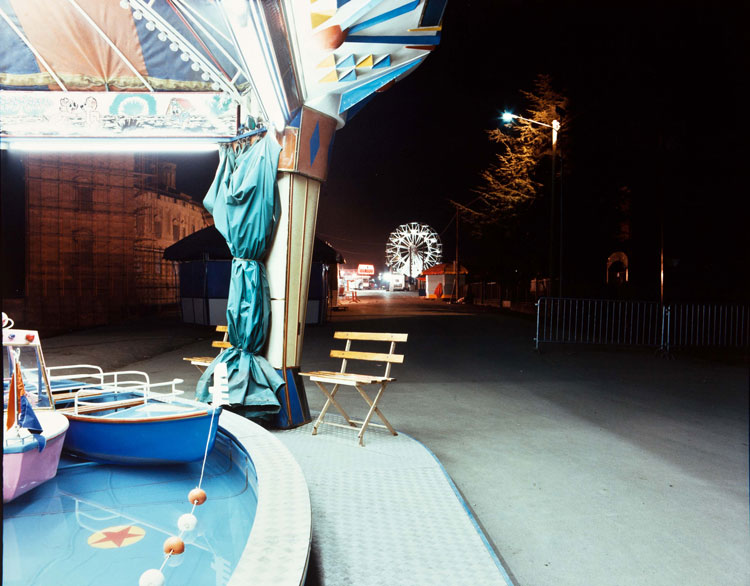
Luigi Ghirri. Scandiano, presso la Rocca di Boiardo, 1985. C-print, vintage print. Museo d'arte della Svizzera italiana, Lugano. Collezione Città di Lugano. Photo: Museo d'arte della Svizzera italiana, Lugano. Collezione Città di Lugano.
James Lingwood, the curator of this show, encapsulates Ghirri’s aesthetic and cultural inspirations at the opening: “He began this work when European culture was changing very quickly. Two of the phenomena that marked this change were, first, the fact that photography itself was becoming commonplace in Europe at that time. When a family went on holiday, they would most likely take a camera, with … a roll of film. And second, of course, the idea of travelling on holiday became much more widespread through the 1970s.” Ghirri, too, enjoyed touring the landscape of his local region – Italy and Switzerland – and then further afield. He often photographed the major landmarks, along with all the other tourists, but he later admitted that the obvious shots would be discarded for the less obvious, the unexpected moments that articulate his underlying theme, which Lingwood describes as: “The symbiotic relationship between photography and travel and tourism and the way that the people viewed and experienced it. Photography formed and framed expectation and experiences as part of a new way of seeing that became much more commonplace in the 1970s.”
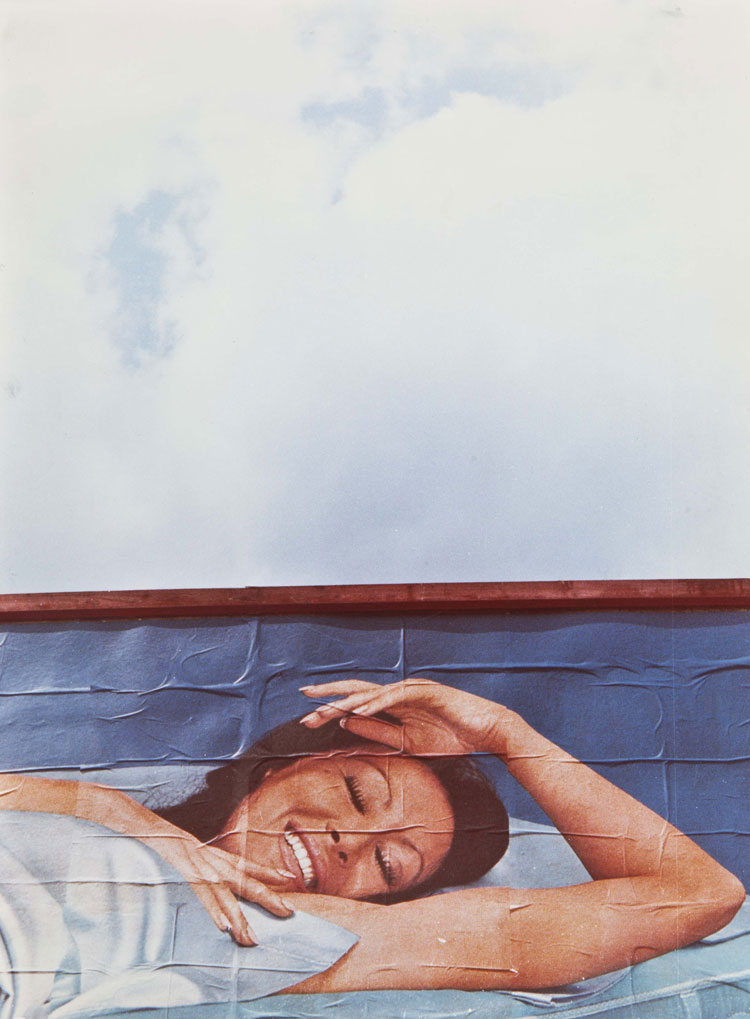
Luigi Ghirri. Modena, 1973. C-print, vintage print. Collection Massimo Orsini, Mutina for Art. Photo: Massimo Orsini, Private Collection.
The allure and glamour of travel, and the seduction of sea and mountains in particular, were quickly seized on by the also burgeoning advertising and marketing industries, whether promoting a place or a product. And it is the humorous placement of this tourism ephemera that the show opens with, in a section titled Cardboard Landscapes. Cryptic collages abound: a torn slice of blue sky (from a poster) framed by a brick wall (Egmond aan Zee, 1973); a billowing dune of ochre-rendered facade under fragments of a cruise ship poster (Bastia, 1976); a bored-looking couple sitting down to dine at a restaurant, oblivious to the huge waves appearing to break over them in the mural on the wall (Bologna, 1973). Of this period of regular weekend outings into the cities and landscapes around him, Ghirri wrote: “Reality is being transformed into a colossal photograph, and the photomontage already exists: it’s called the real world.”
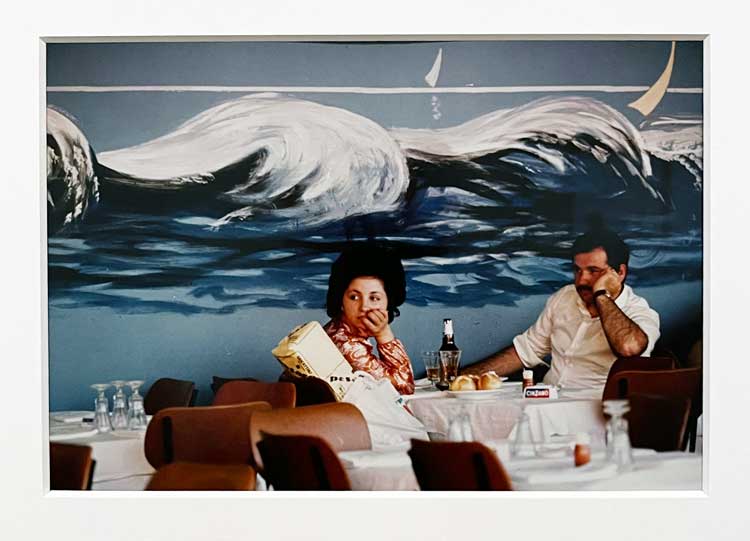
Luigi Ghirri, Bologna, 1973. Installation view, Luigi Ghirri. Viaggi: Photographs 1970-1991, MASI (Museo d’arte della Svizzera Italiana), Lugano, Switzerland. Photo: Veronica Simpson.
How little did he realise the degree to which that blurring of boundaries between real and imagined would intensify, 50 years later, in our transition from largely analogue to predominantly digital lives. And how pertinent is his reflection that this mash-up of aspirational imagery and urban reality reflects “the gap between what we are and the image of what we’re supposed to be”. Many of these early images would go into his first book, published in 1978, called Kodachrome.
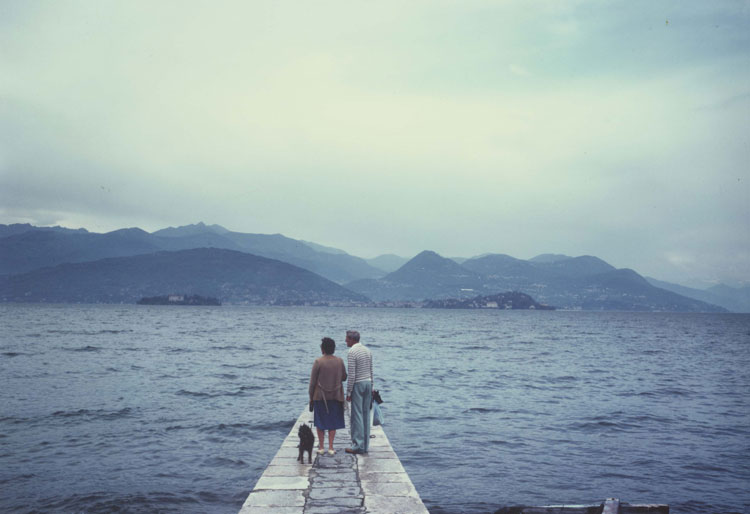
Luigi Ghirri. Lago Maggiore, 1984. Cibachrome print, new print (1990-91). CSAC, Università di Parma. Photo: CSAC, Università di Parma.
In the next section of the show, titled Mountains, Lakes, Sun and Sea, Ghirri is touring further afield, to the Dolomites and the Swiss Alps, exploring the coastline of the Adriatic and the Mediterranean, even venturing to Paris and Amsterdam. Again, he may photograph the iconic view, but never from a stereotypical perspective. In Lago Maggiore (1984), he chooses a moody, overcast shot of the lake, the mountains undulating quiet and blue in the distance, and draws our attention instead to a man, a woman and a dog, standing on the jetty, their backs towards us. He often photographs enviably wide stretches of sandy beach, but is more likely to present them devoid of human activity, foregrounding instead the play and leisure infrastructure (merry-go-rounds, slides, swings and goalposts) awaiting animation and thus highlighting the scene’s artificiality.
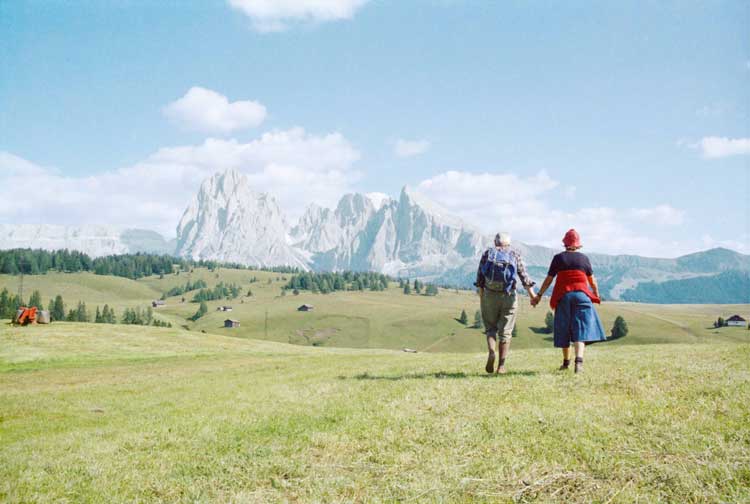
Luigi Ghirri. Alpe di Siusi, 1979. C-print, new print (2001). Courtesy Estate of Luigi Ghirri. © Estate of Luigi Ghirri.
Although the title of the show Viaggi (Trips) implies external adventuring, two of Ghirri’s most important series were those conducted in the home, and these form the heart of the show: Atlante (1973) and Identikit (1976). In the former, Ghirri uses a macro lens to create closeups of mountains, deserts, night skies and oceans taken from his own atlas – the point, as Lingwood says, where all journeys begin; or at least they did until Google Maps. I am particularly charmed by the pixelated contours of his Atlas Mountains. For the Identikit series, he pays close attention to the ephemera in his own home that powers his imagination – books, records, maps and souvenirs – and said he regarded this as his self-portrait.
In the late 70s and 80s, Ghirri toured Italy extensively, expanding his repertoire with a medium format camera to help achieve greater depth of field and colour intensity in his prints. This series is shown in a section titled Journeys in Italy. As ever, if a recognisable landmark or landscape is in the frame, it is almost always animated by the story of those who are visiting it – for example, two women wearing white hats and leaning against a marble balustrade in Rome, with the dome of St Peter’s in the distance (Roma, 1979) or a woman standing in one of the great galleries of Florence, gazing at a Renaissance nude – her head, with its shiny, bobbed helmet of hair, tastefully obscuring our view of the nude’s crotch (Firenze, 1986). The curators have also had fun with this selection, for example pairing a photo of the pretend Eiffel Tower, taken in the aforementioned Italia in Miniatura theme park (Rimini, 1977), next to the head of a tourist wearing a bandanna and sitting by a lake admiring his Eiffel Tower souvenir – which turns out to have been taken in Paris (Paris, 1972). As Lingwood says: “These are photos of the expectations of travel, the image of travel, the experience of tourism.”
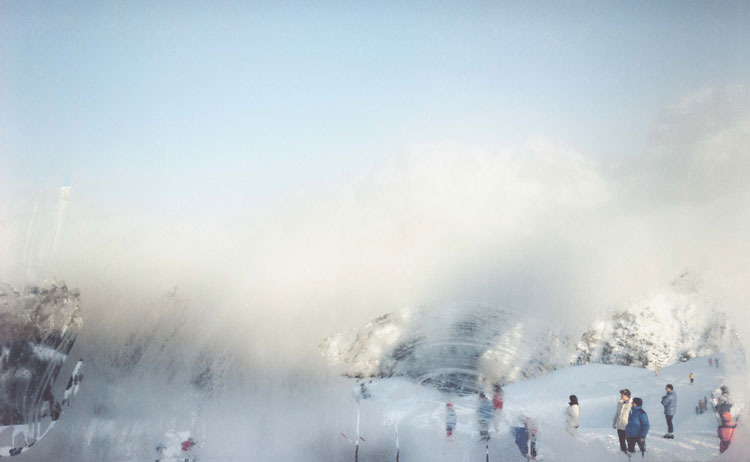
Luigi Ghirri. Rifugio Grosté. 1983. Lambda print, new print (2013). Courtesy Estate of Luigi Ghirri. © Estate of Luigi Ghirri.
Lingwood, formerly co-director of the groundbreaking Artangel art agency (see interview in Studio International this year), has been a fan of Ghirri’s for the last decade. And it is thanks to his advocacy and enthusiasm, plus the co-operation of Ghirri’s family, through the Estate of Luigi Ghirri, plus the collection of CSAC in Parma, that this show has been brought about. But Ghirri is clearly not some overlooked photographer being discovered anew. He was quite a force in the fine art photography landscape of his life, as a wall of illustrated timelines reveals at the far end of the show. He was thinking like an artist, much more than a photographer, as early as 1974, evidenced by Infinite, a series he took of the sky – 365 images for every day of the year – which was exhibited in Pisa and Milan; in 1975, his work was included in a show in Kassel, Art as Photography – Photography as Art, and the same year he was hailed by Time Life magazine as “the discovery of the year”. In 1977, he set up the publishing house Punto e Virgola with his “companion in life and work” Paola Borgonzoni and his friend Giovanni Chiaramonte. In 1978, they published his book Kodachrome, in collaboration with Parisian imprint Contrejour. His work was also included in the L’Imagine Provocata’ section at the 1978 Venice Biennale.
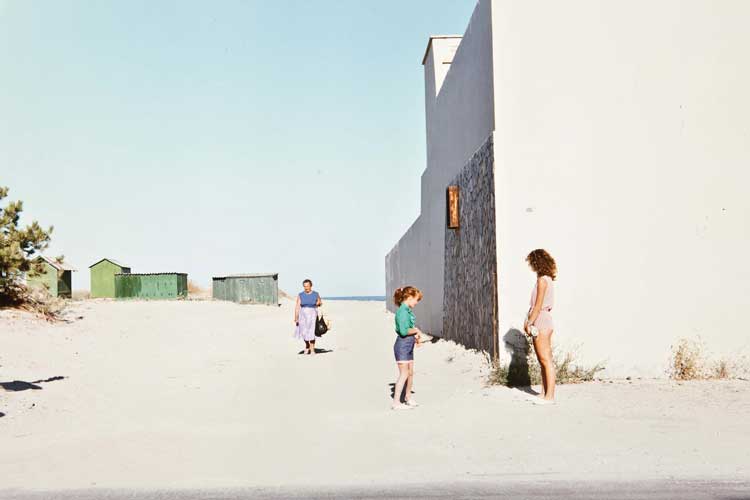
Luigi Ghirri. Marina di Ravenna, 1986. C-print, vintage print. Courtesy Estate of Luigi Ghirri. © Estate of Luigi Ghirri.
In the 1980s, his star continued to rise, with shows in New York, and teaching at the University of Parma. A group show he organised with Enzo Velati and Gianni Leone in 1984 is still regarded as a milestone in Italian contemporary photography. And in 1985, he was invited by the French ministry of culture to photograph Versailles – with several images from this series appearing here. As you would expect, it is not the pomp and rococo finery of this grandstanding project by French royalty that is foregrounded. In one shot, the splendour of the palace is a smear in the distance, barely visible; the focus instead being on a crumpled group of ordinary folk picnicking by the linear lake, utterly at ease in this opulence; another brings a slice of palace into view, celebrating its geometries along with those of the formal gardens, but really these are as backdrop to the tiny figures, in everyday dress, animating the scene.
That ability to simultaneously zoom in and out, to draw our attention to the detail while admiring the whole, is ever present – the eye of the surveyor, as Lingwood observes: “His work combines the clarity and calmness with which a surveyor views and frames his subject together with the sensibility of a visual storyteller, a poet, someone who thought deeply about the role of images in the world.”
When Lingwood claims Ghirri as “one of the most singular artist photographers active in Europe during the second half of the 20th century”, I have to agree.